胰岛素泵评分标准
- 格式:docx
- 大小:15.61 KB
- 文档页数:2

精品资料
胰岛素泵考核标准
........................................
安徽省糖尿病专科护士培训基地
胰岛素泵操作评分标准
姓名:工作单位:
得分:
监考人:
时间:
注+意事项:
1、血糖监测:置泵后头三天监测血糖7次/d,即早中晚三餐前、三餐后2h及凌晨2时的血糖,第4天起视血糖控制情况改为每日3~4次,尤其是置泵后3~7天为胰岛素剂量调整期,容易发生低血糖,所以要加强血糖监测。
2、局部皮肤护理:
①输注导管在皮下保留3~5天(冬季可适当延长至5 ~7天),更换一次输注部位和导管系统。
新注射部位与原注射部位应相隔2~3cm以上,原注射针眼处用碘酊或碘伏消毒
②每天检查输注部位及导管系统2次以上,查看是否有红肿,出血及针头脱出、导管扭曲等,如有感染,应立即更换输注部位和装置,严格执行无菌技术操作。
3、严防输注装置阻塞处理。
4、对患者做好携泵指导:
①妥善放置胰岛素泵,洗澡时可使用快速分离器将泵脱开,但不应>1h,沐浴完毕应立即装上。
淋浴时间短可不取泵,用塑料袋将泵装好挂在脖子上即
可,避免将泵摔至地上或沉入水底,也不应将泵置于气温>45。
C或 <1.5 。
C的环境中,防止胰岛素失效。
②特殊检查时应注意避免将泵直接置于X线下,如患者需行CT、核磁共振及其他放射性检查时,应使用快速分离器将泵取下,检查完后再接上。
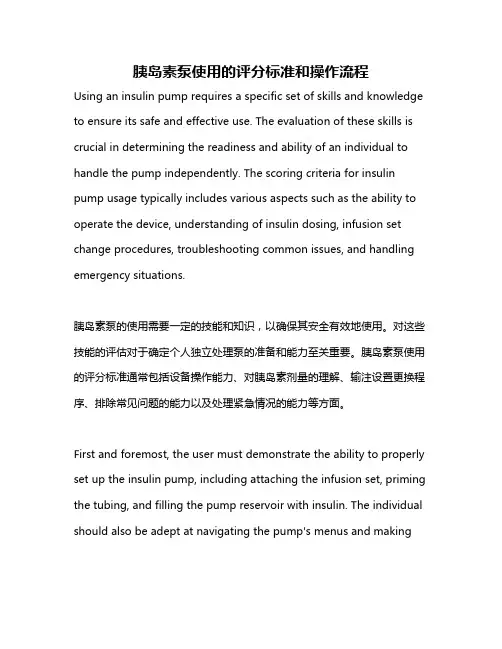
胰岛素泵使用的评分标准和操作流程Using an insulin pump requires a specific set of skills and knowledge to ensure its safe and effective use. The evaluation of these skills is crucial in determining the readiness and ability of an individual to handle the pump independently. The scoring criteria for insulin pump usage typically includes various aspects such as the ability to operate the device, understanding of insulin dosing, infusion set change procedures, troubleshooting common issues, and handling emergency situations.胰岛素泵的使用需要一定的技能和知识,以确保其安全有效地使用。
对这些技能的评估对于确定个人独立处理泵的准备和能力至关重要。
胰岛素泵使用的评分标准通常包括设备操作能力、对胰岛素剂量的理解、输注设置更换程序、排除常见问题的能力以及处理紧急情况的能力等方面。
First and foremost, the user must demonstrate the ability to properly set up the insulin pump, including attaching the infusion set, priming the tubing, and filling the pump reservoir with insulin. The individual should also be adept at navigating the pump's menus and makingadjustments to basal rates, insulin-to-carb ratios, and correction factors as per their healthcare provider's instructions.首先,用户必须展示正确设置胰岛素泵的能力,包括安装输注设置、给管道进行预灌和用胰岛素填充泵储液室。
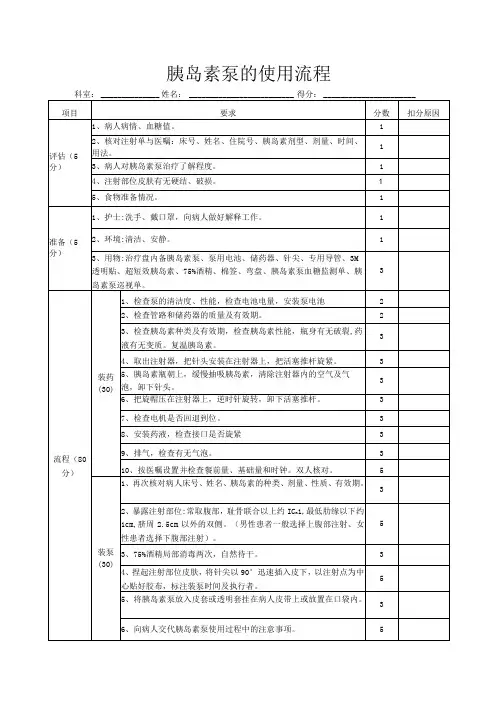
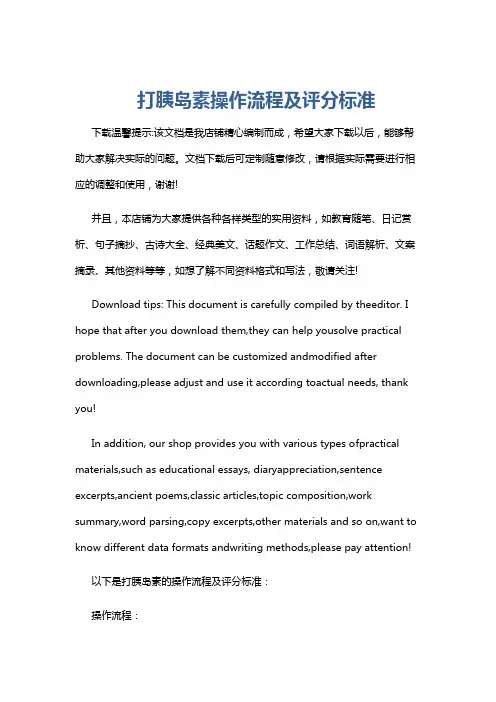
打胰岛素操作流程及评分标准下载温馨提示:该文档是我店铺精心编制而成,希望大家下载以后,能够帮助大家解决实际的问题。
文档下载后可定制随意修改,请根据实际需要进行相应的调整和使用,谢谢!并且,本店铺为大家提供各种各样类型的实用资料,如教育随笔、日记赏析、句子摘抄、古诗大全、经典美文、话题作文、工作总结、词语解析、文案摘录、其他资料等等,如想了解不同资料格式和写法,敬请关注!Download tips: This document is carefully compiled by theeditor. I hope that after you download them,they can help yousolve practical problems. The document can be customized andmodified after downloading,please adjust and use it according toactual needs, thank you!In addition, our shop provides you with various types ofpractical materials,such as educational essays, diaryappreciation,sentence excerpts,ancient poems,classic articles,topic composition,work summary,word parsing,copy excerpts,other materials and so on,want to know different data formats andwriting methods,please pay attention!以下是打胰岛素的操作流程及评分标准:操作流程:1. 准备物品:胰岛素注射器或胰岛素笔、胰岛素、酒精棉球、消毒棉签。
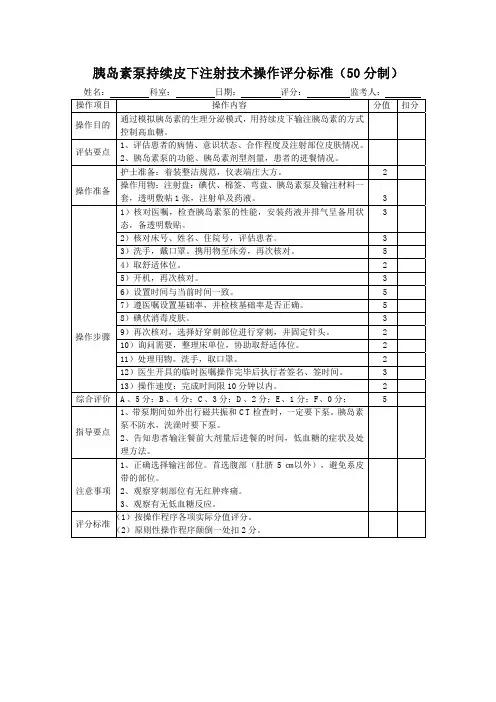
胰岛素泵持续皮下注射技术操作评分标准(50分制)姓名:科室:日期:评分:监考人:操作项目操作内容分值扣分操作目的通过模拟胰岛素的生理分泌模式,用持续皮下输注胰岛素的方式控制高血糖。
评估要点1、评估患者的病情、意识状态、合作程度及注射部位皮肤情况。
2、胰岛素泵的功能、胰岛素剂型剂量,患者的进餐情况。
护士准备:着装整洁规范,仪表端庄大方。
2操作准备操作用物:注射盘:碘伏、棉签、弯盘、胰岛素泵及输注材料一套,透明敷帖1张,注射单及药液。
31)核对医嘱,检查胰岛素泵的性能,安装药液并排气呈备用状态,备透明敷贴。
32)核对床号、姓名、住院号,评估患者。
33)洗手,戴口罩。
携用物至床旁,再次核对。
54)取舒适体位。
2 5)开机,再次核对。
36)设置时间与当前时间一致。
57)遵医嘱设置基础率,并检核基础率是否正确。
58)碘伏消毒皮肤。
3 9)再次核对,选择好穿刺部位进行穿刺,并固定针头。
210)询问需要,整理床单位,协助取舒适体位。
211)处理用物。
洗手,取口罩。
212)医生开具的临时医嘱操作完毕后执行者签名、签时间。
3操作步骤13)操作速度:完成时间限10分钟以内。
2 综合评价A、5分;B、4分;C、3分;D、2分;E、1分;F、0分; 5指导要点1、带泵期间如外出行磁共振和CT检查时,一定要下泵。
胰岛素泵不防水,洗澡时要下泵。
2、告知患者输注餐前大剂量后进餐的时间,低血糖的症状及处理方法。
注意事项1、正确选择输注部位。
首选腹部(肚脐5㎝以外),避免系皮带的部位。
2、观察穿刺部位有无红肿疼痛。
3、观察有无低血糖反应。
评分标准(1)按操作程序各项实际分值评分。
(2)原则性操作程序颠倒一处扣2分。
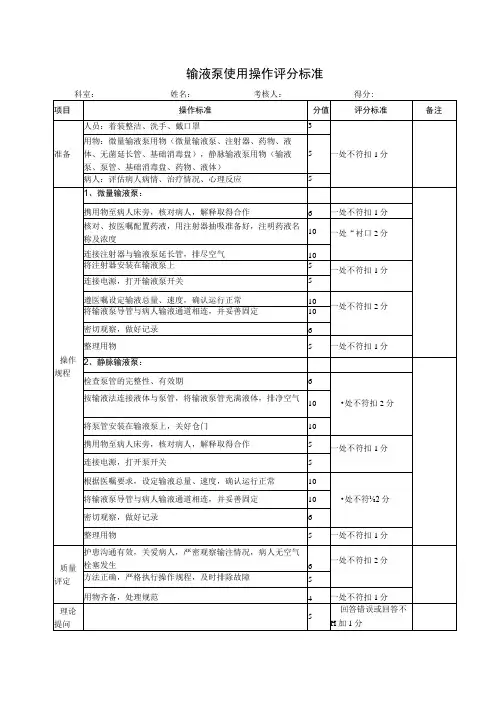
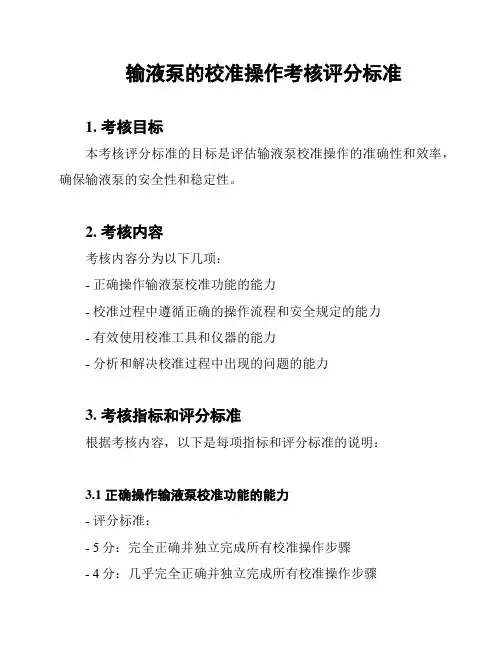
输液泵的校准操作考核评分标准1. 考核目标本考核评分标准的目标是评估输液泵校准操作的准确性和效率,确保输液泵的安全性和稳定性。
2. 考核内容考核内容分为以下几项:- 正确操作输液泵校准功能的能力- 校准过程中遵循正确的操作流程和安全规定的能力- 有效使用校准工具和仪器的能力- 分析和解决校准过程中出现的问题的能力3. 考核指标和评分标准根据考核内容,以下是每项指标和评分标准的说明:3.1 正确操作输液泵校准功能的能力- 评分标准:- 5分:完全正确并独立完成所有校准操作步骤- 4分:几乎完全正确并独立完成所有校准操作步骤- 3分:基本正确并独立完成大部分校准操作步骤- 2分:有一些错误但仍能完成大部分校准操作步骤- 1分:无法独立完成校准操作步骤3.2 校准过程中遵循正确的操作流程和安全规定的能力- 评分标准:- 5分:始终遵循正确的操作流程和安全规定- 4分:大部分时间遵循正确的操作流程和安全规定- 3分:有一些违规但能在提醒下纠正- 2分:经常违规但在提醒下能纠正- 1分:经常违反操作流程和安全规定3.3 有效使用校准工具和仪器的能力- 评分标准:- 5分:准确使用所有校准工具和仪器- 4分:大部分时间准确使用校准工具和仪器- 3分:一些操作需要提醒才能准确使用校准工具和仪器- 2分:经常需要提醒才能准确使用校准工具和仪器- 1分:无法准确使用校准工具和仪器3.4 分析和解决校准过程中出现的问题的能力- 评分标准:- 5分:能独立分析和解决所有校准过程中出现的问题- 4分:大部分时间能独立分析和解决校准过程中出现的问题- 3分:有一些问题需要他人帮助才能解决- 2分:经常需要他人帮助才能解决校准过程中出现的问题- 1分:无法独立解决校准过程中出现的问题4. 总结以上为对输液泵的校准操作考核评分标准的说明。
通过此评分标准,可以评估操作人员在输液泵校准操作方面的能力,为进一步提高校准操作的准确性和效率提供指导和反馈。
![胰岛素泵操作流程及评分标准[1]](https://uimg.taocdn.com/98ff1b0e960590c69fc37683.webp)
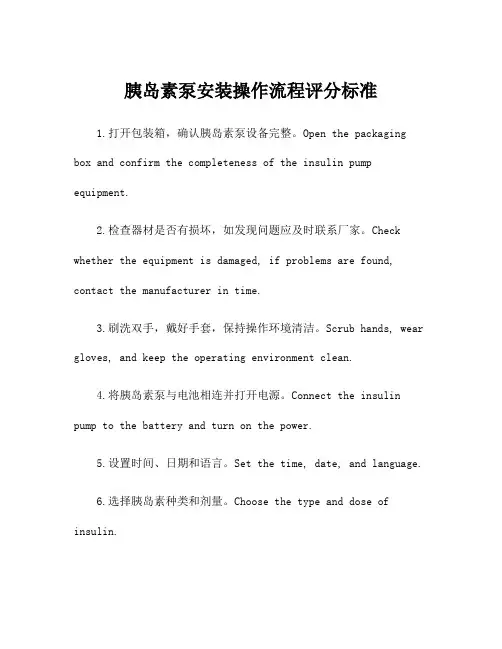
胰岛素泵安装操作流程评分标准1.打开包装箱,确认胰岛素泵设备完整。
Open the packaging box and confirm the completeness of the insulin pump equipment.2.检查器材是否有损坏,如发现问题应及时联系厂家。
Check whether the equipment is damaged, if problems are found, contact the manufacturer in time.3.刷洗双手,戴好手套,保持操作环境清洁。
Scrub hands, wear gloves, and keep the operating environment clean.4.将胰岛素泵与电池相连并打开电源。
Connect the insulin pump to the battery and turn on the power.5.设置时间、日期和语言。
Set the time, date, and language.6.选择胰岛素种类和剂量。
Choose the type and dose of insulin.7.插入胰岛素药水,确认注入无气泡。
Insert the insulin solution and confirm that there are no air bubbles during injection.8.选择合适的部位,清洁皮肤。
Choose the appropriate site and clean the skin.9.将输送管插入皮下,固定好胰岛素泵。
Insert the infusion tube subcutaneously and secure the insulin pump.10.设置胰岛素泵的脉冲速率和注射频率。
Set the pulse rate and injection frequency of the insulin pump.11.确认无异常情况后,将防水套覆盖在胰岛素泵上。
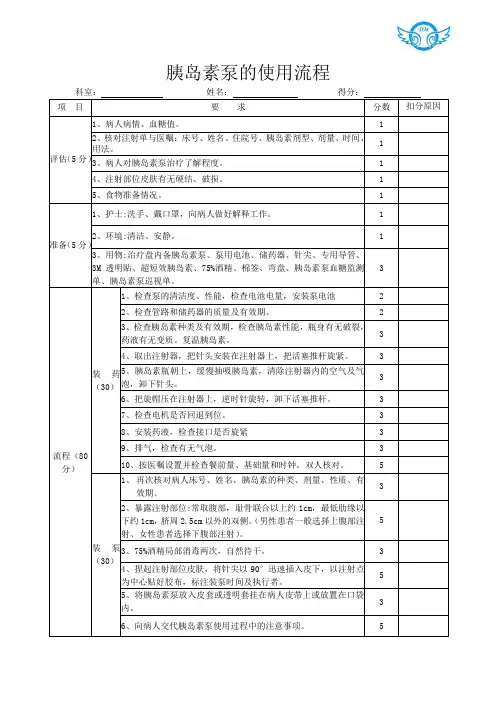
胰岛素泵的使用流程科室: 姓名: 得分: 项 目要 求分数 扣分原因评估(5分) 1、病人病情、血糖值。
1 2、核对注射单与医嘱:床号、姓名、住院号、胰岛素剂型、剂量、时间、用法。
1 3、病人对胰岛素泵治疗了解程度。
1 4、注射部位皮肤有无硬结、破损。
1 5、食物准备情况。
1 准备(5分)1、护士:洗手、戴口罩,向病人做好解释工作。
1 2、环境:清洁、安静。
13、用物:治疗盘内备胰岛素泵、泵用电池、储药器、针尖、专用导管、3M 透明贴、超短效胰岛素、75%酒精、棉签、弯盘、胰岛素泵血糖监测单、胰岛素泵巡视单。
3流程(80分)装药(30) 1、检查泵的清洁度、性能,检查电池电量,安装泵电池 2 2、检查管路和储药器的质量及有效期。
2 3、检查胰岛素种类及有效期,检查胰岛素性能,瓶身有无破裂,药液有无变质。
复温胰岛素。
3 4、取出注射器,把针头安装在注射器上,把活塞推杆旋紧。
3 5、胰岛素瓶朝上,缓慢抽吸胰岛素,清除注射器内的空气及气泡,卸下针头。
3 6、把旋帽压在注射器上,逆时针旋转,卸下活塞推杆。
3 7、检查电机是否回退到位。
3 8、安装药液,检查接口是否旋紧3 9、排气,检查有无气泡。
3 10、按医嘱设置并检查餐前量、基础量和时钟。
双人核对。
5 装泵(30)1、 再次核对病人床号、姓名、胰岛素的种类、剂量、性质、有效期。
32、暴露注射部位:常取腹部,耻骨联合以上约1cm ,最低肋缘以下约1cm ,脐周2.5cm 以外的双侧。
(男性患者一般选择上腹部注射、女性患者选择下腹部注射)。
53、75%酒精局部消毒两次,自然待干。
3 4、捏起注射部位皮肤,将针尖以90°迅速插入皮下,以注射点为中心贴好胶布,标注装泵时间及执行者。
5 5、将胰岛素泵放入皮套或透明套挂在病人皮带上或放置在口袋内。
3 6、向病人交代胰岛素泵使用过程中的注意事项。
5考核者签名:考核时间:年月日。
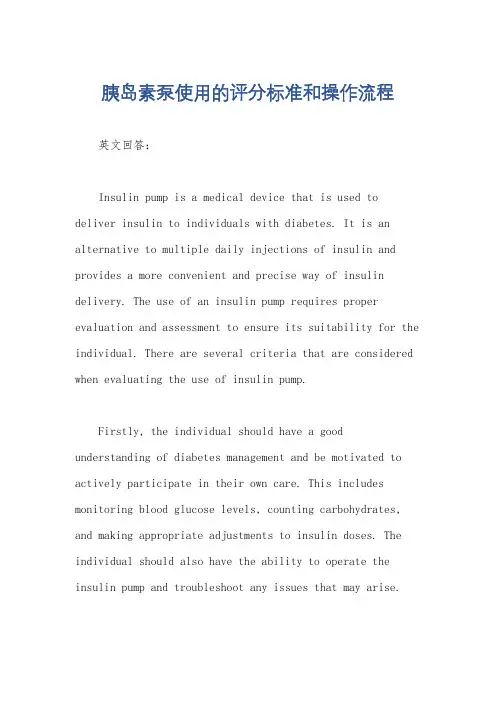
胰岛素泵使用的评分标准和操作流程英文回答:Insulin pump is a medical device that is used todeliver insulin to individuals with diabetes. It is an alternative to multiple daily injections of insulin and provides a more convenient and precise way of insulin delivery. The use of an insulin pump requires proper evaluation and assessment to ensure its suitability for the individual. There are several criteria that are considered when evaluating the use of insulin pump.Firstly, the individual should have a good understanding of diabetes management and be motivated to actively participate in their own care. This includes monitoring blood glucose levels, counting carbohydrates, and making appropriate adjustments to insulin doses. The individual should also have the ability to operate the insulin pump and troubleshoot any issues that may arise.Secondly, the individual should have a stable and predictable lifestyle. This is important because theinsulin pump requires regular monitoring and adjustments to basal rates and bolus doses. If the individual's lifestyle is constantly changing or unpredictable, it may be challenging to maintain proper insulin delivery and control blood glucose levels.Thirdly, the individual should have the support of a healthcare team that is knowledgeable and experienced in insulin pump therapy. This includes healthcare professionals who can provide education and training on the use of the insulin pump, as well as ongoing support and monitoring to ensure optimal glycemic control.Once the individual meets the criteria for insulin pump use, the next step is to initiate the process of obtaining and starting the pump therapy. This typically involves the following steps:1. Consultation with a healthcare professional: The individual will meet with a healthcare professional, suchas an endocrinologist or diabetes nurse educator, to discuss the use of an insulin pump. The healthcare professional will assess the individual's suitability for pump therapy and provide information on the benefits and risks.2. Pump selection and prescription: If the decision is made to proceed with pump therapy, the healthcare professional will help the individual select an appropriate insulin pump based on their needs and preferences. A prescription for the pump will be provided.3. Pump training: The individual will undergo training on how to use the insulin pump. This includes learning how to program the pump, set basal rates and bolus doses, and troubleshoot common issues. The training may be conducted by a diabetes nurse educator or a representative from the pump manufacturer.4. Pump initiation: Once the individual has completed the training and feels comfortable using the pump, theywill start using it on a daily basis. The healthcareprofessional will provide guidance and support during this transition period.5. Ongoing monitoring and adjustments: After starting the pump therapy, the individual will have regular follow-up appointments with their healthcare team to monitor blood glucose levels, review pump data, and make any necessary adjustments to insulin doses. The healthcare team will also provide ongoing education and support to ensure the individual's success with pump therapy.中文回答:胰岛素泵是一种用于给糖尿病患者输送胰岛素的医疗设备。
;’. 注射泵操作评分标准科室:姓名:操作时间:成绩:项目操作方法分值评分标准得分操作前准备(30)1.仪表端庄,着装整洁 5 一项不符扣2分2.评估患者:病情,用药剂量、有无静脉通路。
3.心理状态:有无紧张、焦虑、恐惧感,是否合作。
6 评估不到位扣2分4.环境评估:病房环境整洁安全,有电源插座、注射泵是否处于备用状态。
4 评估不到位扣2分5.洗手、戴口罩6.准备并检查用物:治疗卡、治疗盘、治疗巾、碘伏、酒精、棉签、液体、药品、砂轮、输液贴、弯盘、微量注射泵、20ml或50ml注射器、延长管。
7.洗手、摘口罩15 一项不符扣2分操作流程(60)1、备齐用物,携至患者床旁,核对床号、姓名、向患者解释操作目的及方法,取得合作。
2、洗手、戴口罩10 一项不符扣2分4、固定注射泵于输液架上,接通电源。
2 顺序颠倒不得分5、(1)正确配制药液于20ml或50ml注射器中,连接延长管并排气。
(2)将注射器针筒及活塞柄分别卡于微量注射泵相应的卡口上并固定(3)打开电源开关至显示屏显示,微量泵进行机内自检至显示屏无闪烁及报警(4)确认显示屏右上方显示20ml或50ml字样。
20安装不牢固扣5分,无菌技术不符合要求扣3分4.再次核对医嘱5、遵医嘱设置正确的泵入速度。
6、再次排气,检查延长管内有无气泡。
将微量泵延长管连接与静脉穿刺针。
7、按开始健、观察输注情况。
15 一项不符合要求扣3分5.再次核对,整理用物、洗手、摘口罩。
8一项不符扣2分6. 宣教注意事项、记录。
5 一项不符合扣2分评价(10)1、操作熟练、方法正确。
确保输液管道在位、通畅、无气泡。
2 不熟练扣1分2、严格无菌操作原则,严格执行查对制度。
2 无菌技术不符合要求扣2分3、常见报警的原因与处理。
4 酌情扣分4、使用过后将泵擦拭干净,充电放置,固定位置备用。
2 酌情扣分。
输液泵使用技术操作评分标准一、操作前准备(20 分)1、操作者准备(5 分)着装整洁,洗手,戴口罩(2 分)熟悉输液泵的性能及操作方法(3 分)2、用物准备(10 分)输液泵一台,性能良好,清洁(2 分)配套输液管一套(2 分)遵医嘱准备药液,并核对无误(2 分)治疗盘、碘伏、棉签、止血带、输液贴、弯盘(2 分)必要时备夹板及绷带(2 分)3、评估患者(5 分)了解患者病情、年龄、意识状态、合作程度(2 分)评估患者穿刺部位的皮肤及血管情况(2 分)向患者解释输液泵使用的目的、方法及注意事项,取得患者配合(1 分)二、操作过程(70 分)1、安装输液泵(10 分)将输液泵固定在输液架上,接通电源,打开电源开关(2 分)按输液泵操作说明书安装输液管,确保输液管安装正确、牢固(4 分)排尽输液管内空气,关闭调节夹(4 分)2、设定输液参数(20 分)按医嘱设置输液速度,单位为毫升/小时(10 分)再次核对所设置的输液速度是否正确(5 分)根据需要设置输液总量、报警阈值等参数(5 分)3、穿刺输液(20 分)选择合适的静脉,在穿刺部位上方 6 8cm 处扎止血带,常规消毒皮肤(5 分)再次核对药液,排尽头皮针内空气,进行静脉穿刺,见回血后,妥善固定针头(10 分)松开止血带,打开输液调节夹,按“启动/停止”键,启动输液泵(5 分)4、观察与记录(20 分)观察输液泵的运行情况,包括输液速度是否准确、有无报警等(10 分)观察患者的病情变化,如有无输液反应、局部有无肿胀等(5 分)做好护理记录,包括输液开始时间、输液速度、患者反应等(5 分)三、操作后处理(10 分)1、整理用物(5 分)关闭输液泵电源,取下输液管,毁形后放入医疗垃圾桶(2 分)清洁输液泵,整理治疗盘(3 分)2、患者教育(5 分)向患者及家属交代输液过程中的注意事项,如不要随意调节输液泵的参数等(3 分)告知患者如有不适及时通知医护人员(2 分)四、评分要点1、操作熟练、规范,动作轻柔,符合无菌操作原则(20 分)2、能正确设置输液参数,输液速度准确(20 分)3、能及时观察和处理输液过程中的异常情况(20 分)4、与患者沟通良好,患者能积极配合(10 分)5、用物处理正确,操作后能整理好物品(10 分)五、注意事项1、正确安装输液管,避免扭曲、受压。